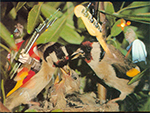Stanisław Szukalski
2 posters
Page 1 of 1
 Re: Stanisław Szukalski
Re: Stanisław Szukalski
What's the frequency Kenneth?
Last edited by senorita panties on Sat Jan 05, 2013 10:31 am; edited 1 time in total

senorita- Posts : 362
Join date : 2012-07-11
Age : 27
Location : makgadikgadi pan
 Re: Stanisław Szukalski
Re: Stanisław Szukalski
This actually makes great sense...for a dream
-----------------------
“Looking through thousands of illustrated books, I have learned how to SEE. Since childhood I have been addicted to seeing ‘pictures’ in books… I learned not only to look, but really SEE, for I did not know English yet and had to jump to CONCLUSIONS. In fact, I evolved the, to other people unnatural, instinct for UNDERSTANDING things, without knowing what they were. Looking became my life’s OBSESSION. When I am dying I will despair over the fact that I will no more be able to Look and See”.
A sample of Szukalski’s science, on the subject of tribal flood scumlines:
“When the Secondary Globe (the lavaic ocean bottoms) began to submerge in the beginning of the last Farsolar Epoch, the global seas were forced to glide off the Primary (Geologic) Globe. The soil of all the lands that were re-emerging was washed off by the departing seas and the water of the globe became very muddy. In fact, Plato, after visiting Egyptian temples, learned of the chronicles that spoke of the Mediterranan Sea as ‘The Sea of Mud’. Homer’s Iliad was about Ilium (the Latin word for ancient Troy) which in Protong means ‘Mire Remembered’. The state of Illinois, U.S.A. is named after the Illinois River, and in Protong (‘Illi No J(e) Z’) actually means ‘Mire made-Born is From’.
“Wherever the terrified diluvial escapees shored re-emerging lands, their faces were caked with mud. And since each swam differently, each would emerge with individual muddy water ripples across the face. So when they lay there in the mud in the deadly faint, exhausted beyond words, and were found by earlier arrivees on that islet, the facial mud markings were remembered and the Flood Scumlines became the tribal markings. I have an entire volume on these Scumlines with 195 such drawings from every part of the globe”.

A head from Rapa Nui (Easter Island). “The horizontal line [the Flood Scumline]
below the nose clearly shows that the ancestor swam to that island in the last Nearsolar Deluge”

“In Equador and the vicinity of the Panama Canal there are Indians who paint their
bodies with black lines emulating the waters in which they stood. They repeat the same lines on their faces,
but the topmost of these crosses their noses, just below the eyes. This means that their diluvial ancestor
buried his face under the water while swimming and made a stronger stroke with his arms when he came up
to get air”

“This Eskimo’s diluvial ancestor swam with the nostrils under water, coming up to inhale
while starting his arm strokes”

“One of the many funerary jars for holding the ashes of the cremated dead.
This one is from prehistoric Poland… Atop the head reposes the cover in the shape of Easter Island.
On their necks are many metal necklaces and, as in this one, the image vomits the salt water of the sea.
These rings on the neck emulate the water ripples spreading from a drowning person. Usually, there is
a large ‘spzilla’ (Polish for ‘pin’) as a Rebus for ‘Z Bi La’ [Protong], which tells us that the person cremated
came ‘From Killed (by) Flood’ land and to there was returning”

“The Chiaco Indian tribe of Equador continue to mark their faces with the Flood Scumline
on the very rim of their upper lip”

“A funerary portrait of a young man drawn from the lid of a large jar that holds the ashes
of a cremated man. It was excavated in Italy and dates from the Etruscan period. On the man’s face
the ancient tribal Flood Scumline was engraved, crossing his mask just below his nose, emulating a beard.
However, the vertical direction of continuous lines tells us that this is really the draining water, heavy with mud.
“The two small circles on the chin and the edge of ripples around them made me turn the drawing
upside down and there I saw that the mask resembled the Great Lioness (Easter Island), streaked
with sliding-off water as if re-emerging from under the Flood”
An indication that contemporary Manapes also survived the Deluge:

“Among ancient carvings of the Dorset Culture of the Point Barrow region
in Alaska, this mask was discovered which white men assume is an imaginary Devil. But you can
plainly see that it is a portrait of a local Sasquatch. Incidentally, in the vertical lines we have
a marvelous document. They were carved there to let us know that this creature, like the ancestors
of the Alaskan Eskimos, also saved himself from the Deluge, for any lines, vertical or horizontal,
represent ‘waters’, hence the Great Flood. There is still another pictograph, besides the vertical
draining-off of muddy water. It is the horizontal line just below the nostrils which, by being placed
above the water level, tell us that his breath, his SOUL, was saved”
“Those that saved themselves from drowning, noticed that these creatures also had the fortune to survive,
so they named them accordingly, everywhere on this globe in one language, my Protong.
The present name Sasquatch was then ‘Sa Z Gladz’, which means ‘Here From Destroyed’ (i.e. the deluged continent)”

"All who eagerly perceive the as yet unnamed are vagabonds".
unurthed.com/2007/12/23/szukalskis-science-of-zermatism
-----------------------
“Looking through thousands of illustrated books, I have learned how to SEE. Since childhood I have been addicted to seeing ‘pictures’ in books… I learned not only to look, but really SEE, for I did not know English yet and had to jump to CONCLUSIONS. In fact, I evolved the, to other people unnatural, instinct for UNDERSTANDING things, without knowing what they were. Looking became my life’s OBSESSION. When I am dying I will despair over the fact that I will no more be able to Look and See”.
A sample of Szukalski’s science, on the subject of tribal flood scumlines:
“When the Secondary Globe (the lavaic ocean bottoms) began to submerge in the beginning of the last Farsolar Epoch, the global seas were forced to glide off the Primary (Geologic) Globe. The soil of all the lands that were re-emerging was washed off by the departing seas and the water of the globe became very muddy. In fact, Plato, after visiting Egyptian temples, learned of the chronicles that spoke of the Mediterranan Sea as ‘The Sea of Mud’. Homer’s Iliad was about Ilium (the Latin word for ancient Troy) which in Protong means ‘Mire Remembered’. The state of Illinois, U.S.A. is named after the Illinois River, and in Protong (‘Illi No J(e) Z’) actually means ‘Mire made-Born is From’.
“Wherever the terrified diluvial escapees shored re-emerging lands, their faces were caked with mud. And since each swam differently, each would emerge with individual muddy water ripples across the face. So when they lay there in the mud in the deadly faint, exhausted beyond words, and were found by earlier arrivees on that islet, the facial mud markings were remembered and the Flood Scumlines became the tribal markings. I have an entire volume on these Scumlines with 195 such drawings from every part of the globe”.

A head from Rapa Nui (Easter Island). “The horizontal line [the Flood Scumline]
below the nose clearly shows that the ancestor swam to that island in the last Nearsolar Deluge”

“In Equador and the vicinity of the Panama Canal there are Indians who paint their
bodies with black lines emulating the waters in which they stood. They repeat the same lines on their faces,
but the topmost of these crosses their noses, just below the eyes. This means that their diluvial ancestor
buried his face under the water while swimming and made a stronger stroke with his arms when he came up
to get air”

“This Eskimo’s diluvial ancestor swam with the nostrils under water, coming up to inhale
while starting his arm strokes”

“One of the many funerary jars for holding the ashes of the cremated dead.
This one is from prehistoric Poland… Atop the head reposes the cover in the shape of Easter Island.
On their necks are many metal necklaces and, as in this one, the image vomits the salt water of the sea.
These rings on the neck emulate the water ripples spreading from a drowning person. Usually, there is
a large ‘spzilla’ (Polish for ‘pin’) as a Rebus for ‘Z Bi La’ [Protong], which tells us that the person cremated
came ‘From Killed (by) Flood’ land and to there was returning”

“The Chiaco Indian tribe of Equador continue to mark their faces with the Flood Scumline
on the very rim of their upper lip”

“A funerary portrait of a young man drawn from the lid of a large jar that holds the ashes
of a cremated man. It was excavated in Italy and dates from the Etruscan period. On the man’s face
the ancient tribal Flood Scumline was engraved, crossing his mask just below his nose, emulating a beard.
However, the vertical direction of continuous lines tells us that this is really the draining water, heavy with mud.
“The two small circles on the chin and the edge of ripples around them made me turn the drawing
upside down and there I saw that the mask resembled the Great Lioness (Easter Island), streaked
with sliding-off water as if re-emerging from under the Flood”
An indication that contemporary Manapes also survived the Deluge:

“Among ancient carvings of the Dorset Culture of the Point Barrow region
in Alaska, this mask was discovered which white men assume is an imaginary Devil. But you can
plainly see that it is a portrait of a local Sasquatch. Incidentally, in the vertical lines we have
a marvelous document. They were carved there to let us know that this creature, like the ancestors
of the Alaskan Eskimos, also saved himself from the Deluge, for any lines, vertical or horizontal,
represent ‘waters’, hence the Great Flood. There is still another pictograph, besides the vertical
draining-off of muddy water. It is the horizontal line just below the nostrils which, by being placed
above the water level, tell us that his breath, his SOUL, was saved”
“Those that saved themselves from drowning, noticed that these creatures also had the fortune to survive,
so they named them accordingly, everywhere on this globe in one language, my Protong.
The present name Sasquatch was then ‘Sa Z Gladz’, which means ‘Here From Destroyed’ (i.e. the deluged continent)”

"All who eagerly perceive the as yet unnamed are vagabonds".
unurthed.com/2007/12/23/szukalskis-science-of-zermatism

usеro- Posts : 130
Join date : 2013-02-25
Page 1 of 1
Permissions in this forum:
You cannot reply to topics in this forum















